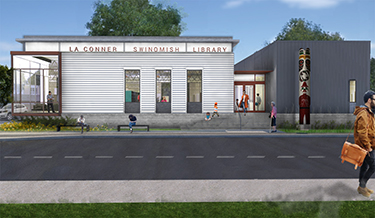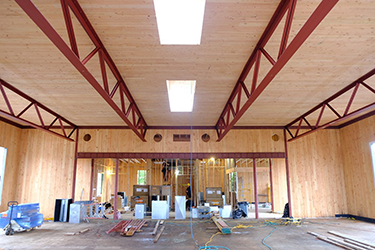|
Subscribe / Renew |
|
|
Contact Us |
|
| ► Subscribe to our Free Weekly Newsletter | |
| home | Welcome, sign in or click here to subscribe. | login |
Architecture & Engineering
| |
March 7, 2022
La Conner, tribe come together to build library made of CLT
A/E Editor
In 2016, architect BuildingWork was selected to design a new public library for the town of La Conner. Following an extended fundraising campaign, design, permitting, and delays related to COVID, six years later the library is now under construction at 520 E. Morris St. and is expected to be complete in June or July.
The 5,500-square-foot library is the result of a unique partnership between the La Conner Regional Library and the Swinomish Indian Tribal Community. The project was initiated by the library following the receipt of partial project funding from the state Legislature. After several years of fundraising efforts, the project still lacked the money needed to get things off the ground. This was until the Swinomish tribe stepped in to become the second largest funder, after the state.
“In La Conner, the tribe and the town are literally separated by a river. This project became a real opportunity for them to come together and build a new public space that is truly for everyone in the community,” Matt Aalfs, principal architect on the project, shared. “I think the new library is a wonderful example of two groups with a challenging history working together to move their community forward in a positive way.”
The new library consists of one large reading room/flexible public space, with sections subdivided by partitions and/or built-in furniture. There is also a separate meeting room. The library will offer a range of expanded services, public access computers, study areas, and improved collections for children, teens and adults.
Patrons will be welcomed by a 28-foot-tall story pole designed and carved by Swinomish elder and master carver Kevin Paul. The pole includes three figures that tell the story of what the library means to Paul and the entire project team. The three figures are an eagle, which represents knowledge and wisdom, a pair of dancing salmon, to represent community and sharing, and the figure of a Coast Salish man, with arms outstretched in a welcoming gesture.
Aalfs shared that the overall design vision was to create a space that felt welcoming to, and that reflected, the diverse community that calls La Conner home. To ensure this, signage at the library is in four languages: English, Spanish, Lushootseed and Braille. BuildingWork also wanted to create a building that respects and acknowledges the history of the area but that also meets the needs of a modern day community and feels contemporary.
The library is being built entirely of cross-laminated timber, a material that evokes both the lumber history of the town and the longhouses of Native American culture. CLT is also a thoroughly modern building technology and was chosen for its sustainability. The primary and secondary structural systems are all made of CLT, and all of the walls and roofs are CLT panels. There is no secondary framing except for long-span steel trusses at the open reading room. The CLT panels will be fully exposed as the interior finish of the walls and ceilings of the new library. The circulation desk, a central feature of any library, is made from a large cedar log that was also used for the story pole.
“We believe this is the first public building in the state that is entirely made of CLT, rather than just a portion, which is more common,” Aalfs said. “This is something we are really excited about. Because this is a public building it also means that more people will be able to experience this material and its benefits, which I think is really special.”
The new library sits within a designated historic district. As a result, BuildingWork had to follow strict guidelines when designing the project. The team began by conducting a photographic survey of the town's significant stock of historic commercial buildings. These buildings inform the design. Elements that reflect the historic architecture of the town include the addition of a large bay window, the use of vertical windows and wood siding. The new building also features scale massing, visual hierarchy and careful proportioning to reference its historic context.
A further design feature that provides a nod to the area's history is the children's reading area, which consists of a 21-foot-long piece of built-in furniture that looks like a tugboat (La Conner is a center for tugboat manufacturing). The tugboat holds children's books and provides special nooks for reading and story times.
Tiger Construction is building the library using CLT panels manufactured by Vaagen Timbers. Work began in late February. The external CLT framing took around five days to install. “It's like a 3D puzzle, the CLT panels arrive on site ready to be put together,” Aalfs explained.
“With this project we really wanted to create a space that belonged to everyone and we think we've achieved that, this was really meaningful work and a humbling experience to see the tribe, the library and the community come together and to see our skills used to create a welcoming public space,” he concluded.
In addition to BuildingWork, the library project team includes: KPFF Consulting Engineers, civil and structural engineer; The Greenbusch Group, mechanical engineer; TFWB Engineers, electrical; RDH Building Science, envelope consultant; Karen Kiest Landscape Architecture; Blanca Lighting Design; ArchEcology, LEED certification; Applied Building Information, specifications; Project Delivery Analysts, cost estimator; and Sierra Pacific Industries, lumber supplier.
BuildingWork's team is led by principal architect Matt Aalfs, project manager Kate Weiland and project architect Jake LaBarre.
Emma Hinchliffe can be
reached by email or by phone
at (206) 622-8272.




